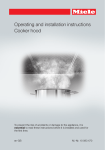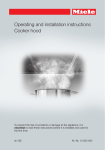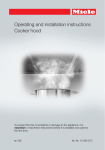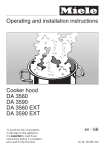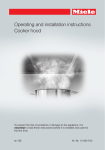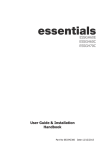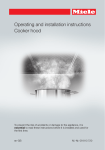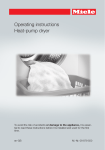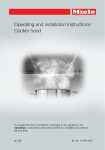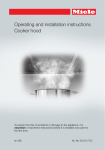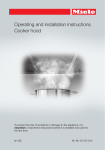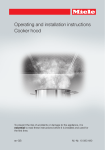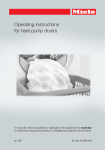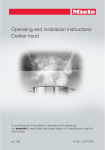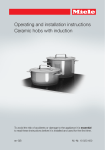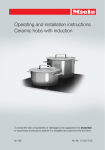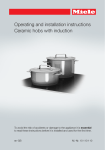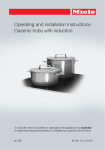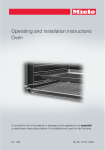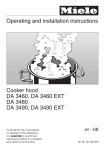Download Miele DA3566 cooker hood
Transcript
Operating and installation instructions Cooker hood To prevent the risk of accidents or damage to the appliance, it is essen‐ tial to read these instructions before it is installed and used for the first time. en-GB M.-Nr. 10 093 480 Contents Warning and Safety instructions .......................................................................... 4 Caring for the environment ................................................................................. 13 Modes of operation.............................................................................................. 14 Con@ctivity 2.0 function ........................................................................................ 15 Guide to the appliance......................................................................................... 16 Operation (Automatic mode)............................................................................... 18 Cooking with Con@ctivity 2.0 (Automatic mode)................................................... 18 Leaving automatic mode temporarily..................................................................... 20 Returning to automatic mode ................................................................................ 20 Operation (Manual mode).................................................................................... 21 Cooking without Con@ctivity 2.0 (Manual mode) .................................................. 21 Switching the fan on .............................................................................................. 21 Selecting the power level....................................................................................... 21 Selecting the run-on time....................................................................................... 22 Switching the fan off .............................................................................................. 22 Switching the hob lighting on/off ........................................................................... 22 Power management ............................................................................................... 23 Operation (Automatic and Manual modes)........................................................ 24 Operating hours counters ...................................................................................... 24 Altering the operating hours counter for the grease filters ............................... 24 Activating and altering the charcoal filter operating hours counter .................. 25 Reading the filter operating hours counter ....................................................... 25 Energy saving tips................................................................................................ 26 Cleaning and care ................................................................................................ 27 Casing .................................................................................................................... 27 Grease filters .......................................................................................................... 28 Charcoal filters ....................................................................................................... 30 Resetting the charcoal filter operating hours counter....................................... 31 Disposing of the charcoal filters ....................................................................... 31 Installation ............................................................................................................ 32 Appliance dimensions............................................................................................ 32 Safety distance between hob and cooker hood (S)............................................... 34 Installation recommendations................................................................................ 35 Before installation .................................................................................................. 35 Assembly parts ...................................................................................................... 36 Exhaust socket ...................................................................................................... 45 2 Contents Setting up for recirculation mode .......................................................................... 46 Electrical connection.............................................................................................. 47 Electrical connection ........................................................................................... 48 Connection for air extraction .............................................................................. 49 Condensate trap .................................................................................................... 50 Silencer .................................................................................................................. 50 Activating Con@ctivity 2.0 ................................................................................... 52 Installing the Con@ctivity 2.0 Stick........................................................................ 52 Activating Con@ctivity 2.0 ..................................................................................... 52 Activating the cooker hood............................................................................... 52 Activating the hob............................................................................................. 53 Activation failed ................................................................................................ 53 Deactivating Con@ctivity 2.0 ................................................................................. 53 After Sales / Guarantee ....................................................................................... 54 Position of the data plate ....................................................................................... 54 Technical data ...................................................................................................... 55 Conformity declaration........................................................................................... 55 3 Warning and Safety instructions This appliance complies with all relevant local and national safety requirements. Inappropriate use can, however, lead to personal in‐ jury and damage to property. To avoid the risk of accidents and damage to the appliance, please read these instructions carefully before using it for the first time. They contain important notes on the safety, installation, use and maintenance of the appliance. Miele cannot be held liable for non-compliance with these instructions. Keep these instructions in a safe place and ensure that all users are familiar with the contents. Pass them on to any future owner of the appliance. Correct application This cooker hood is intended for use in domestic households and similar working and residential environments. The cooker hood is not intended for outdoor use. It must only be used as a domestic appliance to extract vapours and remove odours from cooking. Any other usage is not supported by the manufacturer and could be dangerous. Where a recirculation cooker hood is fitted above a gas hob, please ensure that there is an adequate supply of fresh air into the room in which it is installed. Please seek the advice of a qualified gas fitter (e.g. GasSafe in the UK) if necessary. 4 Warning and Safety instructions The cooker hood can only be used by people with reduced physi‐ cal, sensory or mental capabilities, or lack of experience and knowl‐ edge, if they are supervised whilst using it, or have been shown how to use it in a safe way and recognise and understand the conse‐ quences of incorrect operation. Safety with children Children under 8 years of age must be kept away from the cooker hood unless they are constantly supervised. Children 8 years and older may only use the cooker hood unsu‐ pervised if they have been shown how to use it safely and recognise and understand the consequences of incorrect operation. Children must not be allowed to clean or maintain the cooker hood unsupervised. Please supervise children in the vicinity of the cooker hood and do not let them play with it. Danger of suffocation. Packaging, e.g. plastic wrappings, must be kept out of the reach of babies and children. Whilst playing, children could become entangled in packaging or pull it over their head and suffocate. 5 Warning and Safety instructions Technical safety Unauthorised installation, maintenance and repairs can cause considerable danger for the user. Installation, maintenance and re‐ pairs must only be carried out by a Miele authorised technician. A damaged appliance can be dangerous. Check it for visible signs of damage. Do not use a damaged appliance. The electrical safety of this appliance can only be guaranteed when correctly earthed. It is essential that this standard safety re‐ quirement is met. If in any doubt please have the electrical installa‐ tion tested by a qualified electrician. Reliable and safe operation of this cooker hood can only be as‐ sured if it has been connected to the mains electricity supply. Before connecting the appliance to the mains supply, ensure that the connection data on the data plate (voltage and frequency) match the mains electricity supply. This data must correspond in order to avoid the risk of damage to the appliance. Consult a qualified elec‐ trician if in any doubt. Do not connect the appliance to the mains electricity supply by a multi-socket unit or an extension lead. These are a fire hazard and do not guarantee the required safety of the appliance. For appliances with an external motor fitted (...EXT models) the connection of the two units must be made using the connection ca‐ ble and the plug connectors. These models may only be combined with a Miele external motor. 6 Warning and Safety instructions For safety reasons, this appliance may only be used after it has been built in. The cooker hood must not be used in a non-stationary location (e.g. on a ship). Tampering with electrical connections or components and me‐ chanical parts is highly dangerous to the user and can cause opera‐ tional faults. Only open the housing as described in the instructions given in the installation sheet and in the Cleaning and care section of this book‐ let. Under no circumstances should any other parts of the housing be opened. The manufacturer's warranty will be invalidated if the appliance is not repaired by a Miele approved service technician. Miele can only guarantee the safety of the appliance when genu‐ ine original Miele replacement parts are used. Faulty components must only be replaced by Miele spare parts. If the electrical connection cable is faulty it must only be replaced by a Miele authorised service technician to protect the user from danger. During installation, maintenance and repair work, the appliance must be disconnected from the mains electricity supply. 7 Warning and Safety instructions Using at the same time as other heating appliances that depend on the air from the room Warning - danger of toxic fumes Great care should be taken when using the cooker hood at the same time and in the same room or area of the house as another heating appliance which depends on the air in the room. Such appliances include gas, oil, wood or coal-fired boilers and heaters, continuous flow or other water heaters, gas hobs, cook‐ ers or ovens which draw air in from the room and duct exhaust gases out through a chimney or extraction ducting. When used in extraction mode, with or without an external motor fitted, or in recirculation mode with a recirculation box installed outside the room, the appliance draws air in from the room in which it is installed and from neighbouring rooms. If there is insufficient air, an underpressure will occur. The heating appliance will be starved of oxygen, impairing combustion. Harmful gases could be drawn out of the chimney or extraction ducting back into the room, with potentially fatal consequences. 8 Warning and Safety instructions In order to ensure safe operation, and to prevent gases given off by the heating appliances from being drawn back into the room when the cooker hood and the heater are in operation simultane‐ ously, an underpressure in the room of 0.04 mbar (4 pa) is the maximum permissible. Ventilation can be maintained by air inlets which cannot be blocked, in windows, doors or outside wall vents, or by other technical measures, such as ensuring that the cooker hood can only be switched on when the heating appliance is switched off or vice versa. A ventilation brick alone is not generally sufficient to ensure safe ventilation. The overall ventilation condition of the dwelling must be taken into account. If in any doubt, the advice of a competent builder or, for gas a qualified gas fitter (registered with an official gas safety body in accordance with national safety regulations, GasSafe in the UK) must be sought. If the cooker hood is used in recirculation mode, where the air is directed back into the room in which it is located, operating a heating appliance which depends on the room air at the same time is no cause for concern. 9 Warning and Safety instructions Correct use Never use a naked flame beneath the cooker hood. To avoid the danger of fire, do not flambé or grill over a naked flame. When switched on, the cooker hood could draw flames into the filter. Fat deposits could ignite, presenting a fire hazard. The cooker hood can become damaged when exposed to exces‐ sive heat. – When using the cooker hood over a gas hob, ensure that any burners in use are always covered by a pan. Switch the cooking zone off when a pan is removed, even for a short time. – Select a pan which is suitable for the size of the burner. – Regulate the flame so that it does not burn up the sides of the pan. – Avoid overheating the pan (e.g. when cooking with a wok). Always switch the cooker hood on when a cooking zone is in use, otherwise condensation may collect in the hood, which could cause corrosion. When cooking with oil or fat, chip pans and deep fat fryers etc, do not leave the pans unattended. Never leave an open grill unattended when grilling. Overheated oil and fat can ignite and could set the cooker hood on fire. 10 Warning and Safety instructions Do not use the cooker hood without the filters in place. This way you will avoid the risk of grease and dirt getting into the appliance and hindering its smooth operation. There is a risk of fire if the cooker hood is not cleaned as descri‐ bed in these operating instructions. The cooker hood can get very hot during cooking due to heat ris‐ ing from the hob. Do not touch the housing or the grease filters until the cooker hood has cooled down. Correct installation Refer to the cooker or hob manufacturer's instructions as to whether a cooker hood may be operated above the cooker/hob. Safety regulations prohibit the fitting of a cooker hood over solid fuel stoves. Insufficient distance between the cooker or hob and the cooker hood can result in damage to the hood. The minimum safety distances between the top of the cooker or hob and the bottom of the cooker hood given in the "Installation" section must be maintained, unless the hob manufacturer states that a greater distance is required. If more than one cooking appliance is fitted beneath the cooker hood, and they have different minimum safety distances to the cooker hood, select the greater distance. The distances given in "Installation" must be observed when fit‐ ting the cooker hood. Exhaust ducting must be of non-inflammable material. Suitable material is available from Miele specialist dealers or the Miele Spares Dept. The appliance must not be connected to a chimney or flue which is in use. Neither should it be connected to ducting which ventilates rooms with fireplaces. 11 Warning and Safety instructions If exhaust air is to be extracted into a chimney or ventilation duct no longer used for other purposes, seek professional advice. Cleaning and care Do not use a steam cleaning appliance to clean this appliance. The steam could reach electrical components and cause a short cir‐ cuit. Accessories Only use genuine original Miele accessories with this appliance. Using accessories from other manufacturers will invalidate the guar‐ antee, and Miele cannot accept liability. 12 Caring for the environment Disposal of the packing mate‐ rial The packaging is designed to protect the appliance from damage during transportation. The packaging materials used are selected from materials which are environmentally friendly for disposal and should be recycled. Recycling the packaging reduces the use of raw materials in the manufactur‐ ing process and also reduces the amount of waste in landfill sites. Disposal of your old appliance Electrical and electronic appliances of‐ ten contain valuable materials. They al‐ so contain materials which, if handled or disposed of incorrectly, could be po‐ tentially hazardous to human health and to the environment. They are, however, essential for the correct functioning of your appliance. Please do not therefore dispose of it with your household waste. Please dispose of it at your local com‐ munity waste collection / recycling cen‐ tre or contact your Dealer for advice. Ensure that it presents no danger to children while being stored for disposal. 13 Modes of operation Depending on the model of the cooker hood, the following options are availa‐ ble: Extraction mode The air is drawn in and cleaned by the grease filters and directed outside. Non-return flap Recirculation mode (recirculation mode cooker hoods re‐ quire a conversion kit and charcoal fil‐ ters: see "Technical Data") The air is drawn in and cleaned first by the grease filters and then by the char‐ coal filters. The cleaned air is then recir‐ culated back into the kitchen. The non-return flap is designed to pre‐ vent the exchange of room and outside air taking place. The flap is closed when the cooker hood is switched off. When the cooker hood is switched on, the non-return flap opens for the cook‐ ing vapours to be blown directly out‐ side. Operation with an external mo‐ tor If the on-site ventilation system does not have a non-return flap, the non-re‐ turn flap supplied must be fitted in the exhaust socket in the motor unit. Cooker hoods set up for operation with an external motor have to be connected to a Miele external motor located in a suitable position outside the room in which the cooker hood is installed. The external motor is linked to the cooker hood via a connection cable and then operated using Con@ctivity 2.0 or via the controls on the remote control or the cooker hood. 14 (...EXT model cooker hoods) Modes of operation Con@ctivity 2.0 function Automatic control The cooker hood has a communication facility which enables the automatic op‐ eration of the cooker hood depending on the operational state of the hob. The hob transmits information about its operational status via a wireless signal to the cooker hood. – The hob lighting will switch on auto‐ matically. – With the deflector plate pulled out, during cooking, the cooker hood au‐ tomatically sets the power level ac‐ cording to the number of cooking zones in operation and their power levels. – After the hob has been switched off, the cooker hood fan and the hob lighting will switch off automatically. See "Operation" for detailed informa‐ tion about this function. To make use of the communication fa‐ cility, the hob must be fitted with a Con@ctivity 2.0 Stick . Please refer to the installation instruc‐ tions for the Con@ctivity 2.0 stick to check whether it is compatible with your hob. To use the Con@ctivity 2.0 function, a wireless connection must be establish‐ ed between the hob and the cooker hood (see "Activating Con@ctivity 2.0). 15 Guide to the appliance 16 Guide to the appliance a Pull-out deflector plate b Controls c Grease filters d Hob lighting e Exhaust socket The exhaust socket can also be fitted at the back. f Slots for the charcoal filters g Slots for the grease filters h Charcoal filters Accessory required for recirculation mode i Hob lighting button j On/Off button for fan k Buttons for setting the fan power level l Button for the run-on option m Operating hours button 17 Operation (Automatic mode) When Con@ctivity 2.0 is activated, the cooker hood always works in automatic mode (see "Activating Con@ctivity 2.0"). To operate the cooker hood manually, see "Cooking without Con@ctivity 2.0". Cooking with Con@ctivity 2.0 (Automatic mode) Switch a cooking zone on at the power level you want. The cooker hood lighting will come on. Pull out the deflector plate. The fan will come on at power level 2. The cooker hood selects the power lev‐ el automatically during cooking. This is determined by the total output of the hob, i.e, the number of cooking zones in operation and the power levels selected. If you select a higher power level or are using several cooking zones, the cooker hood will switch to a higher power level. When you reduce the power level or the number of cooking zones on the hob, the cooker hood power level is also reduced. Examples for power levels 1 to 4 18 Reaction time The cooker hood reacts with a slight delay because altering the power level on the hob does not immediately result in a reduction or increase in cooking vapours. Because the hob transmits the informa‐ tion to the cooker hood at intervals, this can also cause delays. The reaction can vary from a few sec‐ onds to a couple of minutes. Operation (Automatic mode) Cooking process Switching off If for example you switch on a cook‐ ing zone at the highest power level to heat a pan for frying and reduce the power level after approx. 60 to 90 seconds*, a cooking process is rec‐ ognised (*60 seconds to 5 minutes for a HiLight hob). Switch off all cooking zones. The cooker hood switches itself on and when the hob power level has been re‐ duced, the hood switches to power lev‐ el 3 and remains at that level for ap‐ prox. 5 minutes. – From the intensive setting 4, the fan switches immediately to level 3. After that the cooker hood power level is determined automatically by the Con@ctivity function. You can select another power level manually before then. The cooker hood fan will reduce its power level over the next few minutes and will eventually switch itself off. This helps to neutralise any lingering vapours and odours in the air. – If the fan is operating at level 3, it will switch to level 2 after approx. 1 mi‐ nute. – From level 2, the fan switches to level 1 after 2 minutes. – After 2 minutes at level 1 the fan switches itself off. – After another 30 seconds the lighting switches off. The cooking process is then finished. If the deflector plate remains pulled out, the cooker hood will switch on auto‐ matically the next time the hob is switched on: a few seconds after the hob is switched on, the cooker hood fan will switch on, first at level 2 briefly before switching immediately to level 1. Thereafter oper‐ ation will be carried out automatically. 19 Operation (Automatic mode) Leaving automatic mode tem‐ porarily To leave automatic mode temporarily during cooking: Manually select a different power lev‐ el, or Manually switch the cooker hood off, or Activate the run-on option on the cooker hood. The fan will switch off after the selected time and the light‐ ing remains switched on. The cooker hood can now be operated manually (see "Cooking without Con@ctivity 2.0"). 20 Returning to automatic mode The cooker hood returns to automatic mode: if the cooker hood has not been used for approx. 5 minutes after selecting a power level manually, or if the manually selected fan power level corresponds to the automatic one again, or if the cooker hood fan and the hob have been switched off for at least 30 seconds. Automatic mode will resume next time the hob is switched on. If you wish to operate the cooker hood manually for a complete cook‐ ing process, switch on the cooker hood fan before switching on the hob. If the cooker hood and the hob have been switched off for at least 30 sec‐ onds after cooking, automatic mode will resume the next time the hob is switched on. Operation (Manual mode) Cooking without Con@ctivity 2.0 (Manual mode) The cooker hood can be operated man‐ ually if: – Con@ctivity 2.0 is not activated. – You have temporarily deactivated Con@ctivity 2.0 (see "Leaving auto‐ matic mode temporarily"). Switching the fan on Selecting the power level For light to heavy cooking vapours and odours, select from power levels 1 to 3. When frying or cooking food with a very strong aroma, select the Intensive set‐ ting IS. For a lower power level, press the "" control, or "" for a higher level. Reducing power on the intensive set‐ ting If Power management is activated (de‐ fault), the fan automatically switches to level 3 after 5 minutes. Pull the deflector plate downwards slightly and then towards you. The fan will switch on at level 2. The symbol and 2 will light up in the power level display. 21 Operation (Manual mode) Selecting the run-on time It is advisable to run the fan for a few minutes after cooking has finished to neutralise any lingering vapours and odours in the air. With the run-on option the fan switches itself off automatically after a pre-selec‐ ted time. After you have finished cooking, press the run-on option control 5 15 – Once: the fan will switch itself off af‐ ter 5 minutes (5 lights up). – Twice: the fan will switch itself off af‐ ter 15 minutes (15 lights up). – If you press the run-on option control 5 15 again, the fan will remain on (5 15 will go out). Switching the fan off Push the deflector plate back in. The next time the deflector plate is pulled out, the cooker hood will operate at power level 2 again. Or switch the fan off with the On/Off button . The symbol will go out. 22 Switching the hob lighting on/off You can switch the hob lighting on and off by pulling the deflector plate out and pushing it in. When the cooker hood deflector plate is pulled out, you can switch the hob lighting on and off with the lighting button . Operation (Manual mode) Power management Switching Power management on/off The cooker hood features a power management system to help save ener‐ gy. The fan power level is reduced and the lighting is switched off automatical‐ ly. You can deactivate Power manage‐ ment. This can result in increased electricity consumption. – If the Intensive setting is selected, the fan automatically switches to lev‐ el 3 after 5 minutes. Press the run-on option button 5 15 for approx. 10 seconds, until 1 lights up in the power level display. – From levels 3, 2 or 1 the power will be reduced by one level after 2 hours and then in 30 minutes stages until the fan finally switches off. Then press in turn, – The hob lighting will switch off auto‐ matically after 12 hours. – the lighting button again. Switch off the fan and the lighting. – the lighting button , – the "" button and then If Power management is switched on, the 1 and IS indicators will light up con‐ stantly. If it is switched off, 1 and IS will flash. Press "" to switch Power manage‐ ment off. The 1 and IS indicators will flash. To switch it on, press "". The 1 and IS indicators will light up constantly. Confirm the setting with the run-on option button 5 15. All the indicator lamps will go out If you do not confirm within 4 minutes, the cooker hood will revert to the old setting. 23 Operation (Automatic and Manual modes) Operating hours counters The number of hours the appliance has been in operation is stored in memory. When the Grease filter symbol or the Charcoal filter symbol lights up, the operating hours counters are signalling that the filters need to be cleaned or changed. Further information about cleaning and changing the filters and resetting the operating hours counter can be found under "Cleaning and care". Altering the operating hours counter for the grease filters You can set the operating hours coun‐ ter for the grease filters to suit the type of cooking you do. The grease filter operating hours coun‐ ter is set at the factory for 30 hours. – Select a shorter time of 20 hours if you roast or fry a lot. – If you only cook occasionally we rec‐ ommend that you still select a short time because grease which has built up gradually over a long period of time will harden on the filters and make cleaning more difficult. – Select a longer time of 40 or 50 hours if you use very little fat for cooking. Use the On/Off control to switch the fan off. Press the run-on control 515 and the operating hours control at the same time. The grease filter symbol and one of the fan power level indicators flash. 24 Fan power level indicators 1 to IS show the time set: 1............................................... 20 hours 2............................................... 30 hours 3............................................... 40 hours IS ............................................. 50 hours Press the "" symbol for a shorter operating time, or the "" symbol to select a longer operating time. Confirm the selection by pressing the operating hours control . All the indicators will go out If you do not confirm within 4 minutes, the cooker hood will revert to the old setting. Operation (Automatic and Manual modes) Activating and altering the charcoal filter operating hours counter Reading the filter operating hours counter Charcoal filters are needed for recircu‐ lation mode. To check the percentage of time set al‐ ready used The charcoal filter operating hours counter needs to be activated once and the operating time needs to be set to suit the kind of cooking you do: Use the On/Off control to switch the fan on. Use the On/Off control to switch the fan off. Press the "" symbol and the oper‐ ating hours control at the same time. The Charcoal filter symbol and one of the fan power levels will flash. Fan power level indicators 1 to IS show the time set: 1............................................. 120 hours 2............................................. 180 hours 3............................................. 240 hours IS ........................................ Deactivated Press the "" symbol for a shorter operating time, or the "" symbol to select a longer operating time. Confirm your choice by pressing the operating hours control . All the indicator lamps will go out. If you do not confirm within 4 minutes, the cooker hood will revert to the old setting. Press and hold the operating hours control – Once, to read the Grease filter oper‐ ating hours. The grease filter symbol lights up. – Twice, to read the Charcoal filter op‐ erating hours. The Charcoal filter symbol lights up. One or more of the power level indica‐ tors will flash. The number of fan power level indica‐ tors flashing shows the percentage of the operating time which has already been used up. 1 ................................................... 25 % 1 and 2 ......................................... 50 % 1 to 3 ............................................ 75 % 1 to IS ......................................... 100 % The number of operating hours used remains in the memory, even when the appliance is switched off or there is a power cut. 25 Energy saving tips This cooker hood operates very effi‐ ciently and economically. The following will help you to save even more energy when using it: – Ensure that there is sufficient ventila‐ tion in the kitchen when cooking. In extraction mode, if there is insuffi‐ cient air flow the cooker hood cannot operate efficiently and this causes in‐ creased operating noise levels. – Always cook with the lowest possible setting. This produces fewer cooking vapours, so you can use a lower cooker hood power level and there‐ fore benefit from reduced energy consumption. – Use the Con@ctivity function. The cooker hood will switch on and off automatically at the optimum power level for the cooking you are doing, which ensures low energy consump‐ tion. – If you are operating the cooker hood manually, please note the following: – Check the power level selected on the cooker hood. A lower power level is generally sufficient for the majority of cooking. Only use the intensive setting when necessary. – When a large volume of cooking vapours are being produced, switch to a high power level in good time. This is more efficient than operating the cooker hood for longer to try to capture cooking vapours which have already been distributed throughout the kitchen. – Make sure that you switch the cooker hood off after use. If cooking vapours and odours still 26 need to be removed from the kitchen air after cooking, use the run-on function. The fan will switch off automatically after the selected run-on time. – Clean or change the filters at regular intervals. Heavily soiled filters reduce performance, increase the risk of fire and are unhygienic. Cleaning and care Casing General information The surfaces and controls are sus‐ ceptible to scratches and abrasion. Please observe the following clean‐ ing instructions. All external surfaces and controls can be cleaned using hot water with a small amount of washing-up liquid applied with a well wrung-out soft sponge or cloth. Do not let moisture get into the cooker hood. Only use a damp cloth when clean‐ ing. This is particularly important around the controls. After cleaning, wipe the surfaces dry using a soft cloth. Do not use: – cleaning agents containing soda, acids, chlorides or solvents, – abrasive cleaning agents, e.g. pow‐ der cleaners or cream cleaners and abrasive sponges, as well as pot scourers or sponges which have been used previously with abrasive cleaning agents. These will damage the surface material. Important for appliances with stain‐ less steel surfaces (This information does not apply to the controls). Stainless steel surfaces can be cleaned with a proprietary non-abra‐ sive cleaning agent designed specifi‐ cally for use on stainless steel. To help prevent re-soiling, a propriet‐ ary conditioning agent for stainless steel (available from Miele) can also be used. Follow the manufacturer’s instructions on the packaging. Important for the controls Do not leave soiling on the controls for any length of time. Otherwise they may suffer discolou‐ ration or damage. Remove soiling straight away. Please observe the general notes on cleaning earlier in this section. Do not use stainless steel cleaning agents on the controls. 27 Cleaning and care Grease filters Cleaning interval The re-usable metal grease filters in the appliance remove solid particles (grease, dust, etc.) from the kitchen va‐ pours, preventing soiling of the cooker hood. The grease filters should be cleaned regularly (at least every 3 - 4 weeks) to avoid a build-up of grease. An oversaturated filter is a fire hazard. Clean them immediately if the Grease filter operating hours symbol lights up. You can set the operating hours counter for the grease filters to suit the type of cooking you do (see "Op‐ eration"). Removing a grease filter The grease filter can fall out when you are handling it. This can result in damage to the filter and the hob below. Make sure you hold the filter secure‐ ly at all times when handling it. Remove the grease filters from the slots on the front of the housing 28 Cleaning and care Cleaning the grease filters by hand Clean the filters with a soft nylon brush in a mild solution of hot water and a small amount of washing-up liquid. Do not use "neat" washing up liquid. Unsuitable cleaning agents Unsuitable cleaning agents can cause damage to the surface of the filters if used regularly. Do not use: – cleaning agents containing descaling agents – powder cleaners, cream cleaners – aggressive multi-purpose cleaning agents or spray cleaners for grease – oven sprays Cleaning the grease filters in the dishwasher Place the filters as upright as possi‐ ble in the lower basket, with the short sides upright, ensuring the spray arm is not obstructed. Use a proprietary household dish‐ washer detergent. Select a dishwasher programme with a wash temperature between 50°C and 65°C. Depending on the cleaning agent used, cleaning the filters in a dish‐ washer can cause permanent disco‐ louration to the surface. However, this will not affect the functioning of the fil‐ ters in any way. After cleaning After cleaning, leave the filters to dry on an absorbent surface before re‐ placing them. When removing the filters for clean‐ ing, also clean off any residues of oil or fat from the now accessible hous‐ ing to prevent the risk of these catch‐ ing fire. Push the grease filters back in. 29 Cleaning and care Resetting the grease filter operating hours counter After cleaning, the operating hours counter needs to be re-set. Fitting/replacing charcoal filters The slots for the charcoal filters are lo‐ cated above above the grease filters. Whilst the fan is switched on, press the operating hours control for approx. 3 seconds, until only the 1 is flashing. The grease filter symbol goes out. If you want to clean the grease filter(s) before the operating hours counter has reached its maximum, Press the operating hours control for approx. 6 seconds, until only the 1 is flashing. Remove the cover. It is held in place by magnets. Take the charcoal filters out of their packaging. Charcoal filters With recirculation mode, two charcoal filters must be fitted in addition to the grease filters. These are designed to absorb cooking odours. Charcoal filters can be obtained from your Miele dealer or via the internet at www.miele-shop.com. See end of this booklet for contact details, and "Tech‐ nical data" for type and reference num‐ ber. 30 Insert the charcoal filters in the slots. Replace the cover. When fitting for the first time, activate the operating hours counter (see "Operation"). Cleaning and care When to change the charcoal filters Always replace the charcoal filters when they no longer absorb kitchen odours effectively. They should, however be replaced at least every 6 months. The charcoal filter operating hours sym‐ bol will light up to remind you to change the charcoal filters. The charcoal filter operating hours counter needs to be activated before using for the first time (see "Opera‐ tion"). Resetting the charcoal filter operat‐ ing hours counter After changing the charcoal filters, the operating hours counter needs to be reset. To do this, with the fan switched on, press the operating hours control once, then press it again and hold it for approx. 3 seconds until on‐ ly the 1 is flashing. The Charcoal filter symbol will go out. If you want to replace the charcoal fil‐ ters before the operating hours counter has reached its maximum: Press the operating hours control twice and hold it for approx. 6 seconds until only the 1 is flashing. Disposing of the charcoal filters Used charcoal filters can be disposed of with the normal household waste. 31 Installation Appliance dimensions 30 32 Installation a Extraction, recirculation with conver‐ sion kit DUU 150. b The wall unit carcase needs to be 38 mm shorter than the wall unit door. c Installation is also possible in a 600 mm wide unit. In this case the unit door must open upwards to allow access to the grease filters. This al‐ so applies for adjacent units. d The ducting can also be connected at the back. e After installation the wall unit can be fitted with an interim panel. If this is done make sure that the slots for the grease filters and, for recirculation mode, the charcoal filters remain easily accessible. f Alternatively the wall unit can be fit‐ ted with side sections. g If the hood is installed in a wall unit with a base, openings must be pro‐ vided to enable adjustment of the retaining force of the deflector plate. For example: – The wall unit has side sections, as shown. – The cooker hood is installed in a 600 mm wide unit with units at ei‐ ther side. The height of the wall unit and cut-out dimensions must take account of any accessories fitted, e.g. silencer, DSM module. 33 Installation Safety distance between hob and cooker hood (S) When planning the installation height of your cooker hood, the minimum safety distance between the top of a cooker or hob and the bottom of the cooker hood is as follows, unless a greater distance is specified by the manufacturer of your cooking appliance. See "Warning and Safety" instructions for further information. Cooking appliance Minimum distance S Electric hob 450 mm Electric grill, deep fat fryer (electric) 650 mm Multi-burner gas hob, total output ≤ 12.6 kW, no burner > 4.5 kW 650 mm Multi-burner gas hob, total output > 12.6 kW and ≤ 21.6 kW, no burner > 4.8 kW. 760 mm Multi-burner gas hob, total output > 21.6 kW, or multi-burner gas hob where one burner > 4.8 kW. Not possible Single burner gas hob, output ≤ 6 kW. 650 mm Single burner gas hob, output > 6 kW and ≤ 8.1 kW. 760 mm Single burner gas hob, output > 8.1 kW 34 Not possible Installation Installation recommendations – To achieve optimum vapour extrac‐ tion, the cooker hood must cover the hob. It should be positioned centrally over the hob, not to the side of it. – The hob should be no wider than the cooker hood, and if possible, it should be narrower. Before installation Before installation, it is important to read the information given on the following pages as well as the "Warning and Safety instructions" at the beginning of this booklet. – The installation area must be easily accessible. The cooker hood should be easily accessible and easy to dis‐ mantle in the event that service is re‐ quired. This should be taken into consideration when planning the po‐ sition of cupboards, shelves, ceilings or features in the vicinity of the cook‐ er hood. 35 Installation Assembly parts 36 Installation a 1 collar for exhaust ducting 150 mm. b 1 reducing collar for exhaust duct‐ ing 125 mm. c 1 non-return flap for fitting into the exhaust socket on the motor unit (not needed for recirculation mode) d 2 covers for the brackets. 4 screws M4 x 16 mm for securing the cooker hood to the brackets and for securing the spacer strip. 4 screws M4 x 8 mm for securing the spacer strip. e 2 brackets to support the appliance in the wall unit. f 1 cover for the charcoal filter slots. g 1 spacer strip to conceal the gap between the rear of the appliance and the wall. h Conversion kit for recirculation mode (the conversion kit is not sup‐ plied, but is available as an optional accessory - see "Technical data"). The kit contains an exhaust grille and flexible aluminium hose with hose clips. 2 screws 4 x 40 mm, 2 plugs 6 x 36 mm for securing the cooker hood to the wall (only when fit‐ ting into a 900 mm wide wall unit). 4 screws 4 x 25 mm for securing a 900 mm wide cooker hood. 4 adhesive covers to conceal the fix‐ ing holes which are not required. 12 screws 4 x 15 mm for securing the cooker hood into the wall unit. 1 x T 20 angled key 37 Installation 38 Installation Repositioning the ducting The motor unit can be rotated to allow the ducting to be fitted at the back of the cooker hood. This may be necessa‐ ry if the cooker hood is being fitted in a reduced height wall unit, for example. Repositioning is carried out before in‐ stalling the cooker hood. The cooker hood must be discon‐ nected from the mains. Undo the fixing screws on the front panel of the cooker hood housing and remove the panel. Undo the screws from the cover on the back of the cooker hood housing and remove the cover. Unscrew the fixing screws on the motor unit. Turn the motor unit towards the rear and position the exhaust socket in the cut-out in the back panel of the cooker hood housing. Ensure when turning the motor unit that the con‐ nection cable does not become de‐ tached. Secure the motor unit in its new posi‐ tion. Now secure the cover taken from the back panel to the top of the housing. Refit the front panel and secure it us‐ ing the screws. EXT models On appliances with an external motor (EXT models), the exhaust socket (not the motor unit) needs to be reposi‐ tioned. Unscrew the fixing screws and pull the top and bottom sections of the socket apart. Position the top section of the socket over the cut-out in the back panel of the cooker hood housing and attach the bottom section to it from inside. Secure the exhaust socket with the fixing screws. 39 Installation Pull the grease filters out of the slots in the front of the cooker hood hous‐ ing. The spacer strip needs to be attached to the back of the cooker hood housing before the cooker hood is installed in the wall unit. The spacer strip can be attached to the upper or lower edge of the deflector plate. Calculate the measurement T for the spacer strip Cut the spacer strip to measurement T. Score along the groove for the smaller measurement as shown, and remove the surplus. 40 Screw the spacer strip to the back of the cooker hood at the required posi‐ tion. Use the screws supplied. To at‐ tach the spacer strip to the lower edge use the screws previously re‐ moved from the housing unit. Installation Screw the brackets onto the right and left inside walls of the housing unit so that they are flush with the bottom edges of the unit. The brackets are designed for 16 and 19 mm thick unit sides. Orientate the bracket so that the vertical depth matches the thick‐ ness of the unit side, as shown. Fit the screws for attaching the cook‐ er hood so that they protrude by about 5 mm, as shown. Only use the front screws when fitting a 900 mm wide cooker hood in a 600 mm wide wall unit. 41 Installation Tighten the four fixing screws from below. Fit the cooker hood into the wall unit from below. Guide it back over the safety notch until it is correctly hung in the wall unit. Pull the deflector plate downwards slightly and then towards you. 42 When fitting a 900 mm wide cooker hood in a 600 mm wide wall unit, in‐ sert the two rear screws at this stage. If the wall unit has side sections, you will also need to secure it to the base on either side. Push the deflector plate back in. Installation When fitting a 900 mm wide cooker hood into a 900 mm wide housing unit without side base supports, the retain‐ ing brackets supplied are used to align the cooker hood and provide additional support. The retaining brackets are se‐ cured to the back panel of the wall unit. If the wall unit does not have a solid back panel, the cooker hood can be se‐ cured directly to the wall using the screws and plugs supplied. An angled key is supplied in case the screws are difficult to access. Realign the cooker hood and tighten up the screws on the casing. Alternatively, the retaining brackets can be secured to the top of the housing unit. To do this, secure the retaining brackets to the front fixing points on the casing. Use the adhesive covers supplied to conceal the fixing holes on the de‐ flector plate which are not used. Loosen the retaining bracket screws and push the brackets back against the rear wall. Align the cooker hood and mark the position of the fixing holes in the wall unit. Now secure the brackets to the wall unit. 43 Installation When retracted, the deflector plate is held in place by magnets. The retaining force of the magnets can be adjusted. The magnets should be adjusted so that the deflector plate is held in place securely on the left and right hand side and can be lowered slightly. An angled key is supplied for adjusting the magnets. Adjust both sides equally. Turn in stages by a half turn each time and check the adjustment by lowering and raising the deflector plate. – Turning the adjusting screws clock‐ wise increases the magnetic retaining force. – Turning the adjusting screws anticlockwise reduces the magnetic re‐ taining force. 44 The covers for the brackets are de‐ signed for 16 mm and 19 mm thick unit sides. Turn the covers so that they are in the appropriate position and fit them onto the brackets. Installation Secure the spacer strip to the bottom of the wall unit as well. Take the grease filters out and re‐ move any protective foil. Replace the grease filters. Exhaust socket Insert the non-return flap, if required. Make sure that it opens easily and closes again by itself. Insert the cover for the charcoal filter slots as shown and close it. It is held in place by magnets. 45 Installation recirculation. A conversion kit, available through your dealer of from Miele is re‐ quired for operating the cooker hood in recirculation mode. You will also need two charcoal filters (see "Technical da‐ ta"). dai2699 Attach the exhaust ducting, e.g. flexi‐ ble hose, to the exhaust socket using a hose clip (available as an optional accessory). When using 125 mm ducting, fit the reducing collar sup‐ plied into the exhaust socket (see "Connection for air extraction"). Attach the exhaust ducting to the ex‐ haust socket on the cooker hood. See "Connection for air extraction" for further instructions on fitting the ducting. Setting up for recirculation mode If site conditions are not suitable for the cooker hood to be used with air extrac‐ tion, the appliance must be set up for 46 Conversion kit DUU 150 with a plastic grille is suitable for fitting in a non-visi‐ ble area at the top of the wall unit. Conversion kit DUU 151 with a stain‐ less steel grille is recommended if the grille is to be fitted in an area which is visible. Fit the conversion kit as described in the installation instructions supplied with the kit. Make sure that the slats in the exhaust grille point towards the centre of the room and not towards a Installation wall or the ceiling. A non-return flap is not used in recir‐ culation mode. Fit the charcoal filters (see "Cleaning and care"). Electrical connection Refer to the notes in “Electrical con‐ nection” and “Warning and Safety in‐ structions” before connecting to the electricity supply. For appliances connected to an ex‐ ternal motor (EXT models): Connect the cooker hood and the ex‐ ternal motor using the connection ca‐ ble and the six-pole plug connector. Connect the cooker hood to the elec‐ tricity supply. 47 Electrical connection All electrical work should be under‐ taken by a suitably qualified and competent person in strict accord‐ ance with current national and local safety regulations (BS 7671 in the UK). Installation, repairs and other work by unqualified persons could be dangerous, for which the manufac‐ turer cannot be held liable. Ensure power is not supplied to the appliance until after installation or re‐ pair work has been carried out. Do not connect the appliance to the mains electricity supply by an exten‐ sion lead. These do not guarantee the required safety of the appliance. If the switch is not accessible after in‐ stallation (depending on country), an additional means of disconnection must be provided for all poles. For extra safety it is advisable to protect the appliance with a suitable residual current device (RCD). Contact a quali‐ fied electrician for advice. The connection data is given on the data plate. This is visible when the grease filters have been removed. En‐ sure that this data matches the house‐ hold mains supply. Brown ................................................live Connection of this appliance should be made via a suitable isolator or a double pole fused spur connection unit which complies with national and local safety regulations and the On-Off switch should be easily accessible after the appliance has been built in. When switched off there must be an all-pole contact gap of 3 mm in the switch (in‐ cluding switch, fuses and relays ac‐ cording to EN 60335). 48 Important This appliance is supplied for connec‐ tion to an a.c. 230 V single phase 50 Hz supply. The wires in the mains lead are coloured in accordance with the follow‐ ing code: Green/yellow ..................................earth Blue..............................................neutral WARNING: THIS APPLIANCE MUST BE EARTH‐ ED Connection for air extraction If this cooker hood is used at the same time as a heating appliance that relies on oxygen from the same room there is a risk in certain circum‐ stances of toxic fumes building up. It is essential that the "Warning and Safety" instructions are observed. The cooker hood should be installed according to local and national build‐ ing regulations. Seek approval from the building inspector where neces‐ sary. Remember that any constriction of the air flow will reduce extraction performance and increase operating noise. If the exhaust is ducted through an outside wall, a telescopic wall vent or a roof vent (available as an optional accessory) is recommended. Use smooth or flexible ducting made from approved non-flammable mate‐ rials for exhaust ducting. When using an external motor, make sure that the exhaust ducting is suffi‐ ciently rigid. The external motor can cause an underpressure which can result in the exhaust ducting distort‐ ing. To achieve the most efficient air ex‐ traction with the lowest noise levels, please note the following: – To ensure efficient air extraction, the diameter of the exhaust ducting should not be less than 150 mm. – If flat ducting is being used, the cross section must not be smaller than the cross sectional area of the exhaust socket. If the exhaust air is to be ducted into a flue, the ducting must be directed in the flow direction of the flue. When ducting is horizontal it must be laid to slope away at at least 1 cm per metre. This is to ensure that con‐ densate cannot drain back into the appliance. If the exhaust ducting is to run through rooms, ceiling space etc. where there may be great variations in temperature between the different areas, the problem of condensation will need to be addressed. The ex‐ haust ducting will need to be suitably insulated. – The exhaust ducting should be as short and straight as possible. – Only use wide radius bends. – The exhaust ducting must not be kinked or compressed. – Ensure that all connections are strong and airtight. 49 Connection for air extraction Condensate trap In addition to insulating the exhaust ducting, we recommend that a suitable condensate trap is also installed to col‐ lect and evaporate any condensate which may occur. Condensate traps for 125 mm or 150 mm ducting are available as optional accessories. When installing a condensate trap, ensure that it is positioned vertically and as closely as possible above the exhaust socket. The arrow on the housing indicates the direction of air-flow. A condensate trap is integrated in cooker hoods which are designed for connection to an external motor (mod‐ el......EXT). 50 Silencer To achieve even further reductions in noise levels, a special silencer (optional accessory) can be fitted in the ducting system. Extraction mode The silencer not only reduces noise from the motor outside the house, but also sounds from outside (e.g. traffic noise). For this reason the silencer must be positioned as close as possible to the ducting exit . Connection for air extraction Recirculation mode The silencer needs to be positioned be‐ tween the exhaust socket and the ex‐ haust grille . Ensure there is adequate space for fitting it. Extraction mode with external motor To minimise noise from the motor in the kitchen, the silencer should be posi‐ tioned in front of the external motor if possible, or, if the ducting is long, above the exhaust socket on the cook‐ er hood . In the case of an external motor located inside the house, fitting a silencer behind the external motor reduces the noise of the motor outside the house. 51 Activating Con@ctivity 2.0 Installing the Con@ctivity 2.0 Stick In order to use the Con@ctivity 2.0 function, the hob must first be fitted with the Con@ctivity 2.0 Stick. Please read the separate installation instructions supplied with the Con@ctivity 2.0 Stick. Activating the cooker hood The hob and cooker hood must be switched off. Press the run-on option button 515 for approx. 10 seconds until the indi‐ cator for power level 1 lights up. Then press in turn, – the "" button, Activating Con@ctivity 2.0 – then the "" button, Wireless connection must be activated between the hob and the cooker hood before the Con@ctivity 2.0 function can be used. – then the lighting button . Both appliances must be installed and operational. Wireless connection must be activated on the cooker hood and the hob at the same time. Activation on the cooker hood is described below. Activation on the hob is described in the relevant Operating and installation instructions. Please refer to the Operat‐ ing instructions before starting. Activate the cooker hood first, then the hob. 52 The cooker hood is now in signing on/off mode. If a wireless connection has not yet been established 2 and 3 will flash at the same time. If a wireless connection has already been established, 2 and 3 will light up constantly (Con@ctivity 2.0 is already activated or a remote control is signed on). To activate Con@ctivity 2.0, press the "" button. The search for a signal will start. Meanwhile, start activating the hob. Activating Con@ctivity 2.0 Activating the hob Activation failed While the cooker hood is searching for a signal, start activating the hob. More information about this can be found in the Operating instructions for the hob. If connection cannot be established despite activating the Con@ctivity function on the cooker hood and hob, the function must be deactiva‐ ted on both appliances and then the procedure repeated. When the hob registers that connec‐ tion has been established, confirm activation on the cooker hood with the run-on option control 515. All indicators will go out. Confirm activation on the hob. Con@ctivity 2.0 is now ready to use. If you do not confirm within 4 minutes, activation will not take place. You only need to carry out the activa‐ tion procedure once. If the appliances are disconnected from the electricity supply, during a power cut for exam‐ ple, they will still remain activated. Deactivating Con@ctivity 2.0 Deactivation on the cooker hood is carried out in the same way as acti‐ vation, by selecting "" instead of "". To deactivate the hob, please refer to the Operating instructions supplied with it. Please bear in mind that disabling the signal will also disable any remote control function and this will have to be activated again. 53 After Sales / Guarantee In the event of a fault which you cannot remedy yourself, please contact your Miele dealer or the Miele Service De‐ partment. Contact details for Miele are given at the back of this manual. N.B. A call-out charge will be applied to service visits where the problem could have been re‐ solved as described in these instruc‐ tions. When contacting your dealer or Miele, please quote the model and serial num‐ ber of your appliance. These are shown on the data plate. Position of the data plate The data plate is located on the casing of the cooker hood and is visible when the cover for the charcoal filter slots is removed. Guarantee: U.K. In the U.K., the appliance is guaranteed for 2 years from the date of purchase. However, you must activate your cover by calling 0330 160 6640 or registering online at www.miele.co.uk. Guarantee: Other countries For information on the appliance guar‐ antee specific to your country please contact Miele. See end of this booklet for contact details. 54 Technical data Fan motor* 90 W Hob lighting DA 3566 2 x 4.5 W DA 3596 3 x 4.5 W Total connected load* DA 3566 99 W DA 3596 103.5 W Voltage, frequency Fuse rating Mains connection cable length AC 230 V, 50 Hz 5A 1.5 m Weight DA 3566 15 kg DA 3596 18 kg DA 3566 EXT 13 kg DA 3596 EXT 16 kg * For EXT models, the connected load will depend on the type of external motor fitted. Length of connection cable to external motor: 1.9 m Special accessories for recirculation mode: Conversion kit DUU 150 or DUU 151 and Miele charcoal filter set DKF 19-1. Contains two charcoal filters. Conformity declaration Miele hereby declares that the cooker hoods listed at the end of this booklet com‐ ply with the basic requirements and other relevant regulations of Guideline 1999/5/EC. A copy of the full Declaration of Conformity can be obtained from the address at the end of this booklet. 55 Technical data Data sheet for domestic cooker hoods In acc. with delegated regulation (EU) No. 65/2014 and regulation (EU) No. 66/2014 MIELE Model name / identifier DA 3566 Annual Energy Consumption (AEChood) 31,5 kWh/year Energy efficiency class A+ (most efficient) to F (least efficient) A+ Energy efficiency index (EEIhood) 41,5 Fluid Dynamic Efficiency (FDEhood) 36,8 Fluid Dynamic Efficiency class A (most efficient) to G (least efficient) A Lighting Efficiency (LEhood) 46,7 lx/W Lighting Efficiency class A (most efficient) to G (least efficient) A Grease Filtering Efficiency 82,8 % Grease Filtering Efficiency class A (most efficient) to G (least efficient) C Airflow at best efficiency point 333,0 m3/h Air flow (min. speed) 220 m3/h Air flow (max. speed) 400 m3/h Air flow (intensive or boost setting) 640 m3/h Max. air flow (Qmax) 640 m3/h Air pressure at best efficiency point 402 Pa Airborne acoustical A-weighted sound power emissions (min. speed) 39 dB Airborne acoustical A-weighted sound power emissions (max. speed) 51 dB Airborne acoustical A-weighted sound power emissions (intensive or boost setting) 63 dB Electrical power input at best efficiency point 101,0 W Power consumption in off mode (Po) W Power consumption in standby mode (Ps) 0,15 W Nominal power of lighting system 9,0 W Average illumination of the lighting system on the cooking surface 420 Ix Time increase factor 0,7 56 Technical data Data sheet for domestic cooker hoods In acc. with delegated regulation (EU) No. 65/2014 and regulation (EU) No. 66/2014 MIELE Model name / identifier DA 3566 EXT Annual Energy Consumption (AEChood) 6,6 kWh/year Energy efficiency class A+ (most efficient) to F (least efficient) A+ Energy efficiency index (EEIhood) 32,4 Fluid Dynamic Efficiency (FDEhood) Fluid Dynamic Efficiency class A (most efficient) to G (least efficient) - Lighting Efficiency (LEhood) 46,7 lx/W Lighting Efficiency class A (most efficient) to G (least efficient) A Grease Filtering Efficiency % Grease Filtering Efficiency class A (most efficient) to G (least efficient) - Airflow at best efficiency point m3/h Air flow (min. speed) m3/h Air flow (max. speed) m3/h Air flow (intensive or boost setting) m3/h Max. air flow (Qmax) m3/h Air pressure at best efficiency point Pa Airborne acoustical A-weighted sound power emissions (min. speed) dB Airborne acoustical A-weighted sound power emissions (max. speed) 0 dB Airborne acoustical A-weighted sound power emissions (intensive or boost setting) dB Electrical power input at best efficiency point W Power consumption in off mode (Po) W Power consumption in standby mode (Ps) 0,15 W Nominal power of lighting system 9,0 W Average illumination of the lighting system on the cooking surface 420 Ix Time increase factor 57 Technical data Data sheet for domestic cooker hoods In acc. with delegated regulation (EU) No. 65/2014 and regulation (EU) No. 66/2014 MIELE Model name / identifier DA 3596 Annual Energy Consumption (AEChood) 34,7 kWh/year Energy efficiency class A+ (most efficient) to F (least efficient) A+ Energy efficiency index (EEIhood) 44,4 Fluid Dynamic Efficiency (FDEhood) 36,8 Fluid Dynamic Efficiency class A (most efficient) to G (least efficient) A Lighting Efficiency (LEhood) 40,0 lx/W Lighting Efficiency class A (most efficient) to G (least efficient) A Grease Filtering Efficiency 82,8 % Grease Filtering Efficiency class A (most efficient) to G (least efficient) C Airflow at best efficiency point 333,0 m3/h Air flow (min. speed) 220 m3/h Air flow (max. speed) 400 m3/h Air flow (intensive or boost setting) 640 m3/h Max. air flow (Qmax) 640 m3/h Air pressure at best efficiency point 402 Pa Airborne acoustical A-weighted sound power emissions (min. speed) 39 dB Airborne acoustical A-weighted sound power emissions (max. speed) 51 dB Airborne acoustical A-weighted sound power emissions (intensive or boost setting) 63 dB Electrical power input at best efficiency point 101,0 W Power consumption in off mode (Po) W Power consumption in standby mode (Ps) 0,15 W Nominal power of lighting system 13,5 W Average illumination of the lighting system on the cooking surface 540 Ix Time increase factor 0,7 58 Technical data Data sheet for domestic cooker hoods In acc. with delegated regulation (EU) No. 65/2014 and regulation (EU) No. 66/2014 MIELE Model name / identifier DA 3596 EXT Annual Energy Consumption (AEChood) 9,9 kWh/year Energy efficiency class A+ (most efficient) to F (least efficient) A+ Energy efficiency index (EEIhood) 43,4 Fluid Dynamic Efficiency (FDEhood) Fluid Dynamic Efficiency class A (most efficient) to G (least efficient) - Lighting Efficiency (LEhood) 40,0 lx/W Lighting Efficiency class A (most efficient) to G (least efficient) A Grease Filtering Efficiency % Grease Filtering Efficiency class A (most efficient) to G (least efficient) - Airflow at best efficiency point m3/h Air flow (min. speed) m3/h Air flow (max. speed) m3/h Air flow (intensive or boost setting) m3/h Max. air flow (Qmax) m3/h Air pressure at best efficiency point Pa Airborne acoustical A-weighted sound power emissions (min. speed) dB Airborne acoustical A-weighted sound power emissions (max. speed) 0 dB Airborne acoustical A-weighted sound power emissions (intensive or boost setting) dB Electrical power input at best efficiency point W Power consumption in off mode (Po) W Power consumption in standby mode (Ps) 0,15 W Nominal power of lighting system 13,5 W Average illumination of the lighting system on the cooking surface 540 Ix Time increase factor 59 United Kingdom Miele Co. Ltd. Fairacres, Marcham Road Abingdon, Oxon, OX14 1TW Customer Contact Centre Tel: 0330 160 6600 E-mail: [email protected] Internet: www.miele.co.uk Australia Miele Australia Pty. Ltd. ACN 005 635 398 ABN 96 005 635 398 1 Gilbert Park Drive, Knoxfield, VIC 3180 Tel: 1300 464 353 Internet: www.miele.com.au China Miele (Shanghai) Trading Ltd. 1-3 Floor, No. 82 Shi Men Yi Road Jing' an District 200040 Shanghai, PRC Tel: +86 21 6157 3500, Fax: +86 21 6157 3511 E-mail: [email protected], Internet: www.miele.cn Miele (Hong Kong) Limited 41/F - 4101, Manhattan Place 23 Wang Tai Road Kowloon Bay, Hong Kong Tel: (852) 2610 1331, Fax: (852)2610 1013 Email: [email protected] India Miele India Pvt. Ltd. Ground Floor, Copia Corporate Suites Plot No. 9, Jasola New Delhi - 110025 Tel: 011-46 900 000, Fax: 011-46 900 001 E-mail: [email protected], Internet: www.miele.in Ireland Miele Ireland Ltd. 2024 Bianconi Avenue Citywest Business Campus, Dublin 24 Tel: (01) 461 07 10, Fax: (01) 461 07 97 E-Mail: [email protected], Internet: www.miele.ie Manufacturer: Miele & Cie. KG Carl-Miele-Straße 29, 33332 Gütersloh, Germany 60 Malaysia Miele Sdn Bhd Suite 12-2, Level 12 Menara Sapura Kencana Petroleum Solaris Dutamas No. 1, Jalan Dutamas 1 50480 Kuala Lumpur, Malaysia Phone: +603-6209-0288 Fax: +603-6205-3768 New Zealand Miele New Zealand Limited IRD 98 463 631 Level 2, 10 College Hill Freemans Bay, Auckland 1011, NZ Tel: 0800 464 353 Internet: www.miele.co.nz Singapore Miele Pte. Ltd. 163 Penang Road # 04 - 03 Winsland House II Singapore 238463 Tel: +65 6735 1191, Fax: +65 6735 1161 E-Mail: [email protected] Internet: www.miele.sg South Africa Miele (Pty) Ltd 63 Peter Place, Bryanston 2194 P.O. Box 69434, Bryanston 2021 Tel: (011) 875 9000, Fax: (011) 875 9035 E-mail: [email protected] Internet: www.miele.co.za United Arab Emirates Miele Appliances Ltd. P.O. Box 11 47 82 Gold & Diamond Park, Sheikh Zayed Road Building 6 / Offices Nos. 6-214 to 6-220 Dubai Tel: +971-4-341 84 44 Fax: +971-4-341 88 52 E-Mail: [email protected] Internet: www.miele.ae DA 3566 DA 3596 DA 3566 EXT DA 3596 EXT en-GB M.-Nr. 10 093 480 / 01
































































